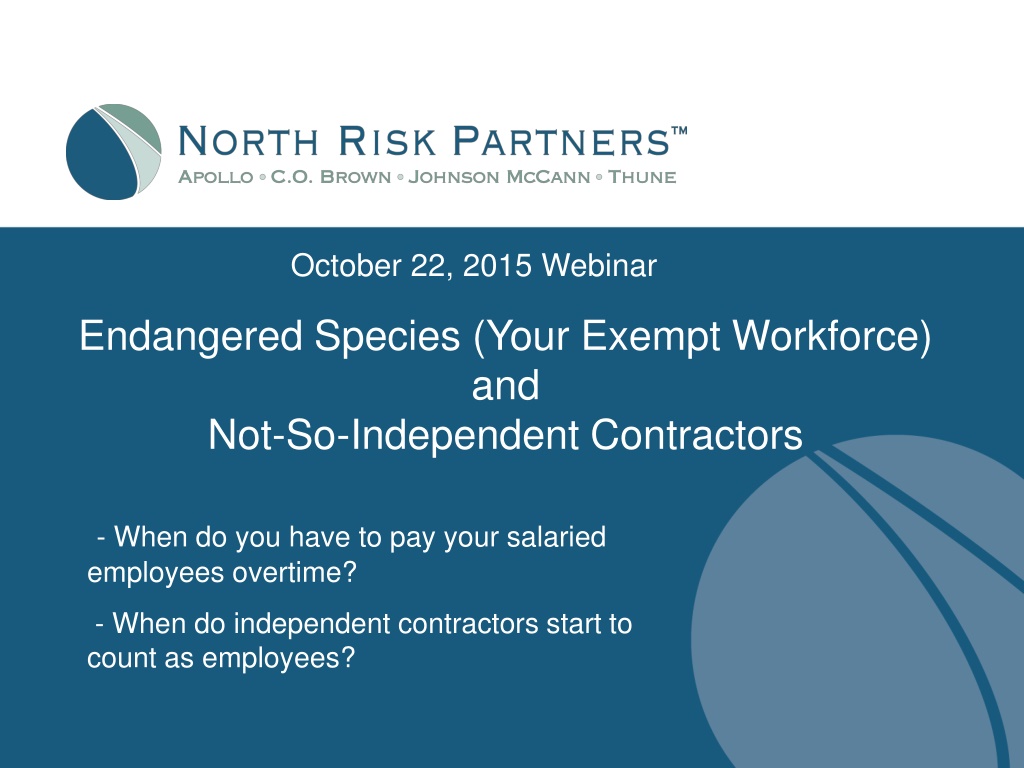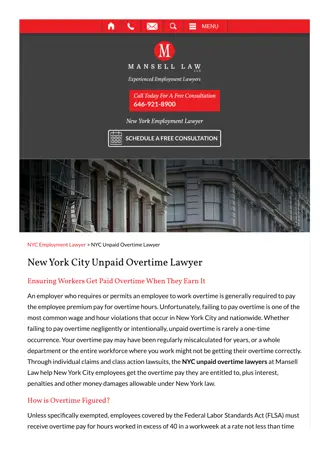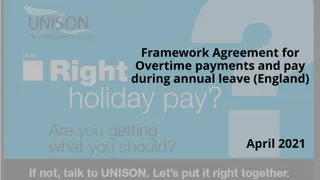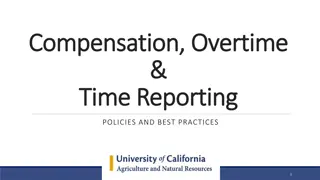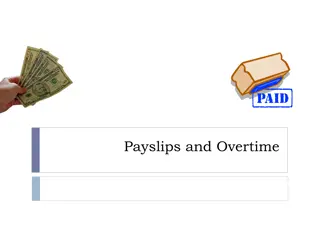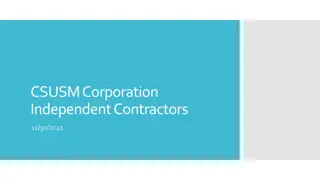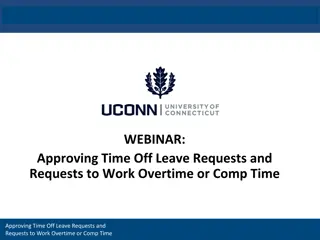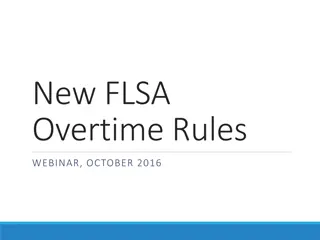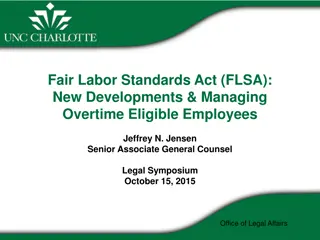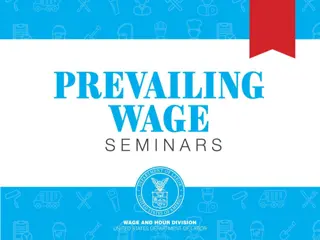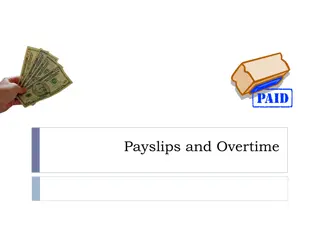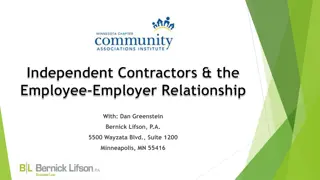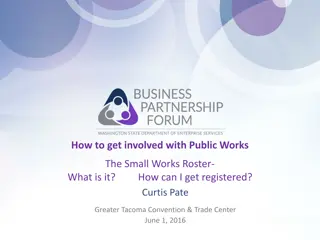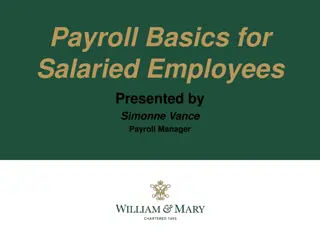Understanding Overtime Regulations for Salaried Employees and Independent Contractors
Explore the complexities of paying overtime to salaried employees and distinguishing independent contractors from employees. Uncover the proposed revisions by the US Department of Labor regarding salary requirements for overtime exemptions, and learn about the potential impact on white-collar exemptions. Delve into the background of FLSA's white-collar exemptions and the criteria employees must meet to qualify. Stay informed about the upcoming changes and consider their implications for your workforce. Presented by Mike Bourgon and Mike Conroy.
- Overtime regulations
- Salaried employees
- Independent contractors
- US Department of Labor
- FLSA exemptions
Download Presentation

Please find below an Image/Link to download the presentation.
The content on the website is provided AS IS for your information and personal use only. It may not be sold, licensed, or shared on other websites without obtaining consent from the author. Download presentation by click this link. If you encounter any issues during the download, it is possible that the publisher has removed the file from their server.
E N D
Presentation Transcript
October 22, 2015 Webinar Endangered Species (Your Exempt Workforce) and Not-So-Independent Contractors - When do you have to pay your salaried employees overtime? - When do independent contractors start to count as employees?
Presented by: Mike Bourgon Mike Conroy
The Endangered Species Your Exempt Workforce How to Prepare for the Department of Labor s Higher Salary Requirement and Revamping of the Duties Test
Introduction On June 30, the US Department of Labor (DOL) announced the highly anticipated proposed revisions to the Fair Labor Standards Act s (FLSA s) overtime exemptions. The proposed revisions increase the minimum salary needed to qualify for the FLSA s standard white collar exemptions to be equal to the 40th percentile of weekly earnings for full-time salaried employees (projected to be $50,440 annually or $970 a week in 2016).
Introduction The DOL also proposes to increase the minimum total annual compensation required to qualify for the highly compensated exemption to be equal to the 90th percentile of earnings for full-time salaried employees ($122,148 per year as of 2013).
Introduction Additionally, the DOL proposes to adjust (and likely increase) these minimum salary and compensation levels on an annual basis.
Introduction The proposed rule does not include changes to the FLSA s duties test , but the DOL nevertheless seeks comments on whether, in light of its compensation proposals, changes to the duties test are necessary. The DOL is providing the public with a 60-day period after the proposed rule is published in Federal Register to comment on it.
Background The FLSA s white collar exemptions exclude certain executive, administrative, and professional employees from federal minimum wage and overtime requirements. Presently, to qualify for one of these exemptions, employees generally must:
Background 1) Be salaried, meaning that they are paid a predetermined and fixed salary that is not subject to reduction because of variations in the quality or quantity of work performed ( salary basis test );
Background 2) Be paid more than a specified salary threshold, currently $455 per week or $23,660 annually (the salary level test ); and
Background 3) Primarily perform executive, administrative, or professional duties as provided in the DOL s regulations (the duties test ).
Background Additionally, certain highly compensated employees are exempt from the FLSA s overtime pay requirements if they are paid total annual compensation of at least $100,000, receive at least $455 per week paid on a salary or fee basis, perform office or non-manual work, and customarily and regularly perform at least one of the exempt duties or responsibilities of an executive, administrative, or professional employee.
DOL Requests for Comment The DOL also seeks comments on a variety of issues throughout the proposal. For example, the DOL is specifically seeking comments from the public on whether to allow incentive compensation and nondiscretionary bonuses, such as a production bonus, to be considered in determining whether the salary-level test is satisfied.
DOL Requests for Comment The DOL is also seeking comments regarding the methodology it should use in annually updating the minimum salary and compensation levels going forward.
DOL Requests for Comment No changes in the duties test are included in the proposed rulemaking. Nonetheless, the DOL is seeking comments on whether the current duties test is working to effectively screen out employees who are not bona fide white collar exempt employees.
DOL Requests for Comment Specifically, the DOL is soliciting comments on What, if any, changes should be made to the duties test; Whether employees should be required to spend a minimum amount of time performing work that is their primary duty in or to quality for an exemption (i.e., a requirement similar to California s 50% requirement for exempt employees);
DOL Requests for Comment Whether the DOL should reinstitute the long/short duties test used prior to the 2004 revisions to the regulations; Whether additional examples of how the exemption may apply to specific jobs should be included in the regulations;
DOL Requests for Comment Whether the concurrent duties regulation for executive employees should be changed; and Suggestions regarding further examples of the application of white collar exemptions to employees in computer-related fields.
DOL Requests for Comment The 295-page proposal was posted on the DOL s website on June 30. Comments are due 60 days after publication, which means that the deadline for submitting comments will be early September, unless an extension to the comment period is granted.
DOL Requests for Comment At this point, it is unclear when the final regulations will be published, but we do not expect them to be issued before 2016. The effective date of the new regulations likely will occur at least 30 60 days after the final regulations are published.
Conclusion The proposed revisions to the FLSA s white collar exemptions are designed to extend overtime protections to millions of employees. Employers should consider the following actions:
Conclusion First, companies and trade associations affected by the proposal and possible changes to the duties tests should consider submitting comments to ensure that the regulatory record reflects the true impact of any proposed changes and to shape the final rule.
Conclusion Second, the significant increase in the compensation required to meet the proposed salary-level test will likely affect long-standing staffing and compensation models. Additionally, the publicity generated by the proposed changes may cause a number of employees to question whether they are properly classified.
Conclusion As such, although any final regulatory change is not imminent, we recommend that companies consider auditing their current employee population to determine what changes will be made to staffing models and the classification of close to the line positions if and when the proposed rule becomes final.
Conclusion Those changes may include raising the salary for certain employees to meet the new proposed standards, bolstering job duties, or reclassifying employees from exempt to nonexempt. Reclassifying exempt employees to nonexempt, in turn, requires considering a broad range of issues, including communication strategy, manager and employee training, timekeeping policies and practices, scheduling, compensation structures, calculation of the overtime rate, and many other issues.
Conclusion Planning ahead is critical to managing the risks associated with reclassification.
Not So Independent Contractors A Review of the New DOL Ground Rules
Introduction The U.S. Department of Labor (USDOL) has launched two major initiatives designed to encourage individual workers who are contract service providers to bring misclassification claims and lawsuits.
Introduction The Department has released extensive new guidance underscoring that independent contractor misclassification remains a top enforcement priority. It is also launching a new outreach program to encourage individual workers to challenge their independent contractor status.
USDOL Administrators Interpretation No. 2015-1
USDOL Administrators Interpretation No. 2015-1 The basic framework for identifying independent contractor status under the wage/hour law has been relatively consistent for many years. USDOL has long had a Fact Sheet outlining its enforcement position.
USDOL Administrators Interpretation No. 2015-1 But, the underlying premise has always been the same: A multi-factor test focusing on whether the worker is economically dependent on the employer, considering the economic realities of the situation, as opposed to truly being in business for him or herself .
USDOL Administrators Interpretation No. 2015-1 On July 15, 2015, the USDOL reiterated this analysis in a lengthy Administrator s Interpretation No. 2015-1, which sets forth six non-exclusive factors that should be used to determine if an individual qualifies as an employee rather than an independent contractor:
USDOL Administrators Interpretation No. 2015-1 Is the work an integral part of the employer s business? Does the worker s managerial skill affect the worker s opportunity for profit or loss? How does the worker s relative investment compare to the employer s investment?
USDOL Administrators Interpretation No. 2015-1 Does the work performed require special skill and initiative? Is the relationship between the worker and the employer permanent or indefinite? What is the nature and degree of the employer s control?
USDOL Administrators Interpretation No. 2015-1 The outcome turns more on the number and weight of the factors as they relate to the ultimate question of economic dependence, than to an employer s control over the worker. No one factor is dispositive. And, because the application of the criteria can be subjective, outcomes vary depending on the judge deciding the case.
Why Does the Administrators Interpretation Matter?
Why Does the Administrators Interpretation Matter? The six factors are not new. What the guidance does is bring more attention to this issue and create an easy-to- use template for just about any plaintiff s lawyer to craft a claim.
Why Does the Administrators Interpretation Matter? It also underscores that USDOL has made independent contractor misclassification a priority and is committed to expending significant resources to attack business models using contractor service providers.
Why Does the Administrators Interpretation Matter? Accordingly, businesses relying on contract service providers now, more than ever, need to carefully assess their contractor relationships.
Business Risk Management Given the costly consequences of misclassification (e.g., payroll taxes, OT pay, Affordable Care Act, FMLA, and other statutory rights), employers need to realistically assess their contractor relationships and actual work practices to determine whether changes are needed to reduce the risk of misclassification.
Business Risk Management Also, businesses need to understand that multiple tests for independent contractor status exist in other federal, state, and local laws. Thus, compliance with the FLSA test alone is not necessarily sufficient.
What To Do Do business only with a business entity that has a business license. Make payment to the business entity.
What To Do Whenever possible, only contract with a business that has its own employees and allow the business to decide which employee or employees will do the work.
What To Do Emphasize and clarify the difference between the company s business and the contract service provider s business. Be prepared to show how the service provider can continue or expand business with or without a contract with the company.
